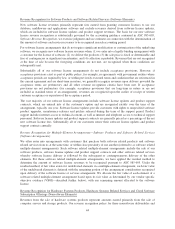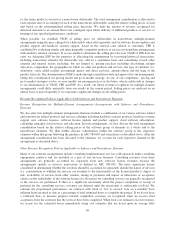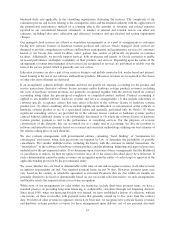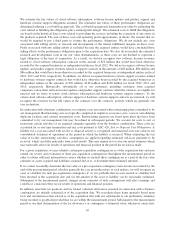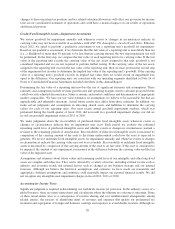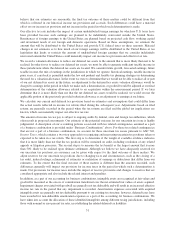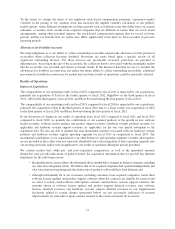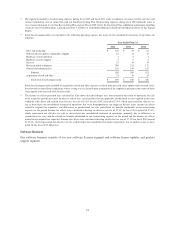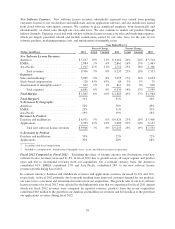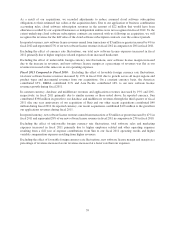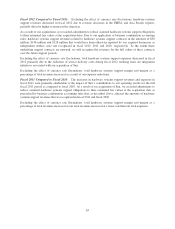Oracle 2012 Annual Report Download - page 57
Download and view the complete annual report
Please find page 57 of the 2012 Oracle annual report below. You can navigate through the pages in the report by either clicking on the pages listed below, or by using the keyword search tool below to find specific information within the annual report.To the extent we change the terms of our employee stock-based compensation programs, experience market
volatility in the pricing of our common stock that increases the implied volatility calculation of our publicly
traded options, refine different assumptions in future periods such as forfeiture rates that differ from our current
estimates, or assume stock awards from acquired companies that are different in nature than our stock award
arrangements, among other potential impacts, the stock-based compensation expense that we record in future
periods and the tax benefits that we realize may differ significantly from what we have recorded in previous
reporting periods.
Allowances for Doubtful Accounts
We make judgments as to our ability to collect outstanding receivables and provide allowances for the portion of
receivables when collection becomes doubtful. Provisions are made based upon a specific review of all
significant outstanding invoices. For those invoices not specifically reviewed, provisions are provided at
differing rates, based upon the age of the receivable, the collection history associated with the geographic region
that the receivable was recorded and current economic trends. If the historical data that we use to calculate the
allowances for doubtful accounts does not reflect the future ability to collect outstanding receivables, additional
provisions for doubtful accounts may be needed and our future results of operations could be materially affected.
Results of Operations
Impact of Acquisitions
The comparability of our operating results in fiscal 2012 compared to fiscal 2011 is impacted by our acquisitions,
primarily the acquisition of Taleo in the fourth quarter of fiscal 2012, RightNow in the third quarter of fiscal
2012, ATG in the third quarter of fiscal 2011 and Phase Forward during the first quarter of fiscal 2011.
The comparability of our operating results in fiscal 2011 compared to fiscal 2010 is impacted by our acquisitions,
primarily the acquisition of Sun in the third quarter of fiscal 2010 and, to a lesser extent, our acquisitions of ATG
in the third quarter of fiscal 2011 and Phase Forward during the first quarter of fiscal 2011.
In our discussion of changes in our results of operations from fiscal 2012 compared to fiscal 2011 and fiscal 2011
compared to fiscal 2010, we quantify the contributions of our acquired products to the growth in new software
license revenues, software license updates and product support revenues, hardware systems products revenues (as
applicable) and hardware systems support revenues (as applicable) for the one year period subsequent to the
acquisition date. We also are able to quantify the total incremental expenses associated with our hardware systems
products and hardware systems support operating segments for fiscal 2011 in comparison to fiscal 2010. The
incremental contributions of our acquisitions to our other businesses and operating segments’ revenues and expenses
are not provided as they either were not separately identifiable due to the integration of these operating segments into
our existing operations and/or were insignificant to our results of operations during the periods presented.
We caution readers that, while pre- and post-acquisition comparisons, as well as the quantified amounts
themselves may provide indications of general trends, the acquisition information that we provide has inherent
limitations for the following reasons:
• the quantifications cannot address the substantial effects attributable to changes in business strategies, including
our sales force integration efforts. We believe that if our acquired companies had operated independently and
sales forces had not been integrated, the relative mix of products sold would have been different; and
• although substantially all of our customers, including customers from acquired companies, renew their
software license updates and product support contracts when the contracts are eligible for renewal and
we strive to renew cloud software subscription contracts and hardware systems support contracts, the
amounts shown as software license updates and product support deferred revenues, new software
licenses deferred revenues and hardware systems support deferred revenues in our supplemental
disclosure related to certain charges (presented below) are not necessarily indicative of revenue
improvements we will achieve upon contract renewal to the extent customers do not renew.
53



